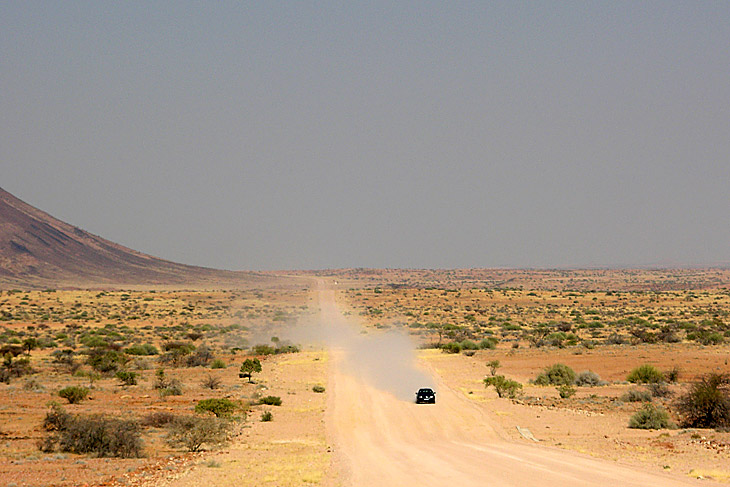We have now traveled over 2,600 km from Francistown, Botswana. The distances have been vast, and we have
seen mountains, desert, dunes, rivers (without water), towns, big cities, vast
areas and some wildlife. Thank God we
both drive; we cannot go more than 500 km a day. We are now back in Namibia’s capital Windhoek
(April 16), leaving this morning at 9:00am after making sure Sam’s house (which
is situated in an oasis in the middle of the desert, on a 18 hole golf course
and they use recycled sewerage water) was clean, locked up and everything
turned off.
We drove
about 50km up the skeleton coast, the bushmen call this area “The Land God Made
in Anger” while the Portuguese once referred to it as “The Gates of Hell”. On this coast there is an upwelling of the
cold Benguela current which gives rise to dense ocean fog (called “cassimbo”),
and we saw this heavy fog a couple of times.
The coast is named for the whale and seal bones which covered the shore
when the whaling industry was still active, as well as the skeletal shipwrecks
caused by rocks offshore in the dense fog.
More than 1,000 vessels of various sizes still litter this coast. Today Swakopmund is a well developed tourist
town (somehow reminded me a little of Key West), which we are told is packed to
capacity during the height of the season (winter months- June – September). We only made 50km driving up the coast, and
there are many more kilometers to go, these are good roads, but we understand
from our map the road will deteriorate.
We stopped
on two occasions just to get out of the bush car and smell the Atlantic and to
pick up some of those beautiful stones.
We eventually get on our way back to Windhoek driving the 320km from
Swakopmund, just savoring what we have done and what we have seen. We try as best we can to describe this
adventure, but it is not easy, the distances are far, sometimes the landscape
changes dramatically. We drive past
about three mines, one of which is uranium, and about three towns Osakos,
Karibib, Okahandja on our way back to Windhoek, just one long road.
We arrive in
Windhoek at 2:30pm, get our room at the Pension Bogainvilla, have lunch,
freshen up and head out to see just a little more of Windhoek and find the
Himba women. The Himba peoples live
mostly in the northern region of Namibia, and Windhoek is located in the center
of Namibia. They are semi-nomadic and
are closely related to the Herero peoples.
The Himba breed cattle and goats.
The responsibility for rearing the livestock, the children and all the
labour intensive work including carrying water lies with the women. Men handle the “political tasks” and “legal”
issues. The Himba are famous for
covering themselves with otjize, which is a mixture of butter fat and ochre,
possible to protect them from insects and the sun. This gives them a reddish tinge, and symbolizes
earth’s rich red colour and blood that symbolizes life and is consistent with
the Himba ideal of beauty. We got to the
craft center which was easy following our GPS, we spot two Himba women, we do
not understand them and they do not understand us (but then what did we expect),
they are selling craft items, someone comes along and translates, we buy souvenirs
from them and take their picture. Very
young women, with beautiful skin, you can see this through the red ochre, and
they have more jewelry than clothes on. Kate
really wants to talk to them, but that is impossible.
Windhoek is
a beautiful city, rolling hills and valleys, orderly, clean, and the German
influence is everywhere.
We head back to
the Pension Bougainvillea for the night to plan our exit out of Namibia the
following day. We are not sure if after
the border we will stop in Ghanzi, Maun, or Nata, all are far distances, the furthest
being Nata. We will see how the border
treats us tomorrow, with prayer I know we will be in good hands.
Blessings
from the Francis’ still in Namibia









No comments:
Post a Comment